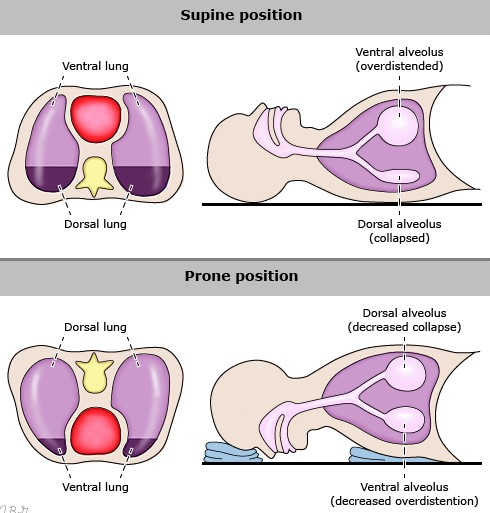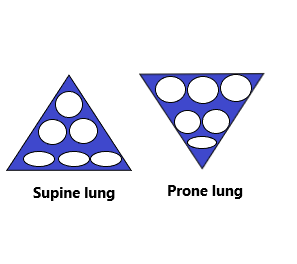In light of the current pandemic sweeping across the globe, keeping us all indoors, I wanted to write about something related to Covid-19…
Something that might be interesting for you to read that’s a bit of a change from the various media updates we are being inundated with at the moment. After all, it’s good to learn something new everyday, right?
You might have heard on the news in recent days, the term ‚proning‘. This basically means laying someone face down.
Normally, when we see patients in hospital, particularly if they are unwell enough to be in the Intensive Care Unit (ICU), they are laid supine (on their back). This seems an obvious choice, the nurses can see the patient’s face for a start, making observational checks easier. There are often numerous lines and tubes attached to the patient, particularly around the face and chest, these can also be checked and altered more easily when the patient is laying on their back.
However, in certain cases, notably some serious respiratory conditions, it is actually more beneficial for the patient to be laying face down. Here’s why:

Think about what’s inside your chest…your heart, lungs, diaphragm and some upper abdominal organs too. When you lay on your back, the weight of those organs cause a compressive force on the areas of your lungs closest to your back. Therefore they cannot expand as fully as when you are upright or when you are laying prone. When someone is suffering from an acute respiratory condition, like Adult Respiratory Distress Syndrome (ARDS), or more topically Covid-19, the lung tissue is essentially swollen and therefore the increased lung mass adds more weight to the struggling areas underneath.
Add the fact that the diaphragm is often paralysed and therefore resting heavily on the lung tissue below, and you have a less than favourable situation for a respiratory-compromised patient.
Imagine lots of little air bags in the lungs, those without any compressive forces imposed on them can expand fully taking as much oxygen in as their size allows. But, if those little air bags are squashed under the weight of the chest wall, like they are when the patient is laid flat on their back, they end up disc-shaped and can only take in a limited amount of oxygen which can lead to those areas of the lungs collapsing.
So, we have a patient in respiratory difficulty laying on their back with the weight of their organs squashing the oxygen out of the areas of their lungs closest to their back, causing collapse. Because they are laying on their back, by the nature of gravity the blood flows heavily to these poorly oxygenated areas of the lungs rather than the areas closest to the front of the chest which are carrying more oxygen. This leads to a situation of high perfusion (blood flow) with low ventilation (oxygen), so the blood doesn’t collect the oxygen it needs to deliver to the rest of the body, which puts the organs at risk.
Let’s turn the patient over into the prone position and see what happens…
The first thing to note is that the lungs ‚fit‘ the chest cavity better in the prone position. Think of the lungs as cone-shaped:

As you can see from the illustration, in supine there is a higher concentration of ’squashed‘ air bags than full ones. The opposite is true when the patient is in the prone position because there are no organs ‚behind‘ the lungs to rest heavily on them.
Therefore oxygenation is increased when the patient is laying face down. The blood can then collect a greater concentration of oxygen from the lungs and deliver it to the rest of the organs where it is needed.
An added bonus of the patient laying prone is that any secretions that have accumulated in the lungs is gradually drained out with the help of gravity, thus keeping the patient’s lungs clearer so they can work more efficiently.
This is a labour-intensive technique, requiring a number of specialist staff at one time, that’s at least 5 plus 1 ‚runner‘ in case there are any problems during the manoeuvre.
Like any procedure it is not without it’s risks, but when a patient is desperately unwell and struggling to manage despite full respiratory support, in some cases it might just be a lifeline.
I want to say an enormous „THANK YOU“ to absolutely everybody, everywhere who is doing their bit in the fight against this devastating illness, including those that are obeying the rules and staying home!

Better days are coming, take care of yourselves.
Thanks for reading, until next time…
Lauren x
